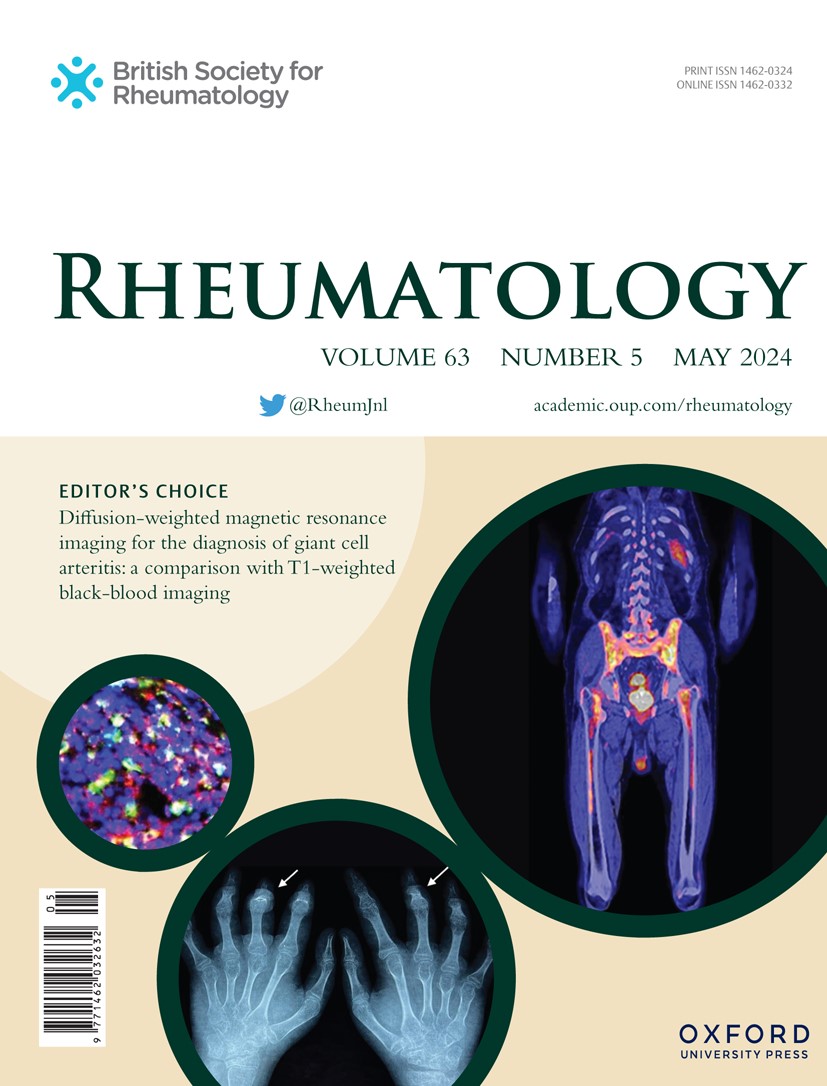Periorbital oedema, trismus, myalgia as muscular manifestations of VEXAS syndrome: a case report and narrative literature review.
IF 4.4
2区 医学
Q1 RHEUMATOLOGY
引用次数: 0
Abstract
OBJECTIVE To report a VEXAS syndrome patient presenting with muscular manifestations, at diagnosis and to review the literature on this rare involvement. METHODS We conducted a narrative review through 3 databases (Cochran, PubMed and Google Scholar) to identify all reports of muscle involvement associated with VEXAS syndrome. No statistical analysis was performed. RESULTS We reported a 73-year-old male VEXAS syndrome patient presenting with muscular manifestations with ptosis, trismus, lower limb myalgia and identified 15 other patients in the literature. All were male with a median age of 71. The most common UBA1 mutations in exon 3, codon 41 involved methionine 41. Muscle inflammation at the onset of VEXAS syndrome was diagnosed by MRI or CT scan. It mostly involved orbital and facial muscles (n = 7), causing diplopia, proptosis, periorbital oedema or chemosis, and the muscles of the lower limbs, causing myalgia, weakness or oedema (n = 7). Muscle histological analysis was also performed in a few cases (n = 5) and revealed an inflammatory infiltrate with macrophages. Other symptoms were quite common: fever, skin and lung involvement, chondritis, arthralgia and thromboembolic events. Corticosteroid therapy was a routine, and the use of corticosteroid-sparing agents was almost systematic. CONCLUSION Taken together, these new data describe the specific muscle involvement of VEXAS syndrome and extend its phenotypic spectrum. It enables us to identify three very distinct manifestations of muscle involvement: orbital, facial, and lower limb inflammation. A case series study would provide a better description of these symptoms.眼眶周围水肿、牙关紧闭、肌痛为VEXAS综合征的肌肉表现:1例报告及叙事文献复习。
目的报告一例以肌肉表现为主要表现的VEXAS综合征患者,并回顾有关这种罕见累及的文献。方法我们通过3个数据库(Cochran、PubMed和谷歌Scholar)进行了一项叙述性综述,以确定所有与VEXAS综合征相关的肌肉受累报告。未进行统计学分析。结果我们报告了一名73岁男性VEXAS综合征患者,其肌肉表现为上睑下垂、咬合、下肢肌痛,并在文献中发现了其他15例患者。研究对象均为男性,平均年龄为71岁。最常见的UBA1突变位于外显子3,密码子41,涉及蛋氨酸41。在VEXAS综合征发病时,通过MRI或CT扫描诊断肌肉炎症。主要累及眶肌和面肌(n = 7),引起复视、眼球突出、眶周水肿或化脓;累及下肢肌肉,引起肌痛、无力或水肿(n = 7)。少数病例(n = 5)也进行了肌肉组织学分析,发现巨噬细胞的炎症浸润。其他症状很常见:发热、皮肤和肺部受累、软骨炎、关节痛和血栓栓塞事件。皮质类固醇治疗是常规的,使用皮质类固醇保留剂几乎是系统的。综上所述,这些新数据描述了VEXAS综合征的特定肌肉受累,并扩展了其表型谱。它使我们能够识别三种非常不同的肌肉受累表现:眼眶、面部和下肢炎症。案例系列研究可以更好地描述这些症状。
本文章由计算机程序翻译,如有差异,请以英文原文为准。
求助全文
约1分钟内获得全文
求助全文
来源期刊

Rheumatology
医学-风湿病学
CiteScore
9.40
自引率
7.30%
发文量
1091
审稿时长
2 months
期刊介绍:
Rheumatology strives to support research and discovery by publishing the highest quality original scientific papers with a focus on basic, clinical and translational research. The journal’s subject areas cover a wide range of paediatric and adult rheumatological conditions from an international perspective. It is an official journal of the British Society for Rheumatology, published by Oxford University Press.
Rheumatology publishes original articles, reviews, editorials, guidelines, concise reports, meta-analyses, original case reports, clinical vignettes, letters and matters arising from published material. The journal takes pride in serving the global rheumatology community, with a focus on high societal impact in the form of podcasts, videos and extended social media presence, and utilizing metrics such as Altmetric. Keep up to date by following the journal on Twitter @RheumJnl.
 求助内容:
求助内容: 应助结果提醒方式:
应助结果提醒方式:


